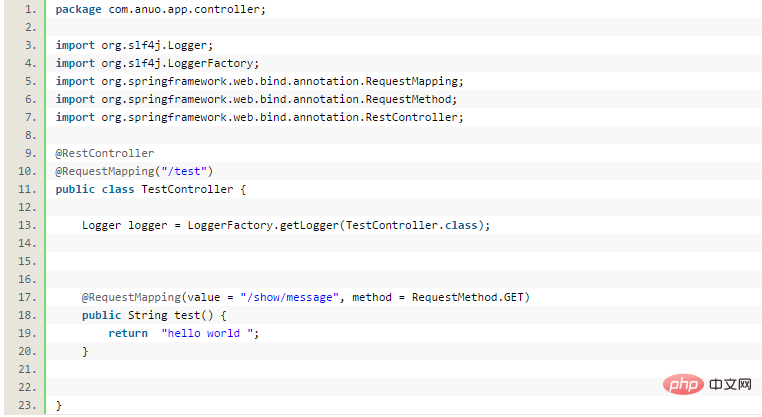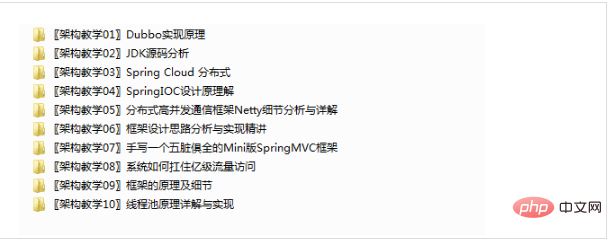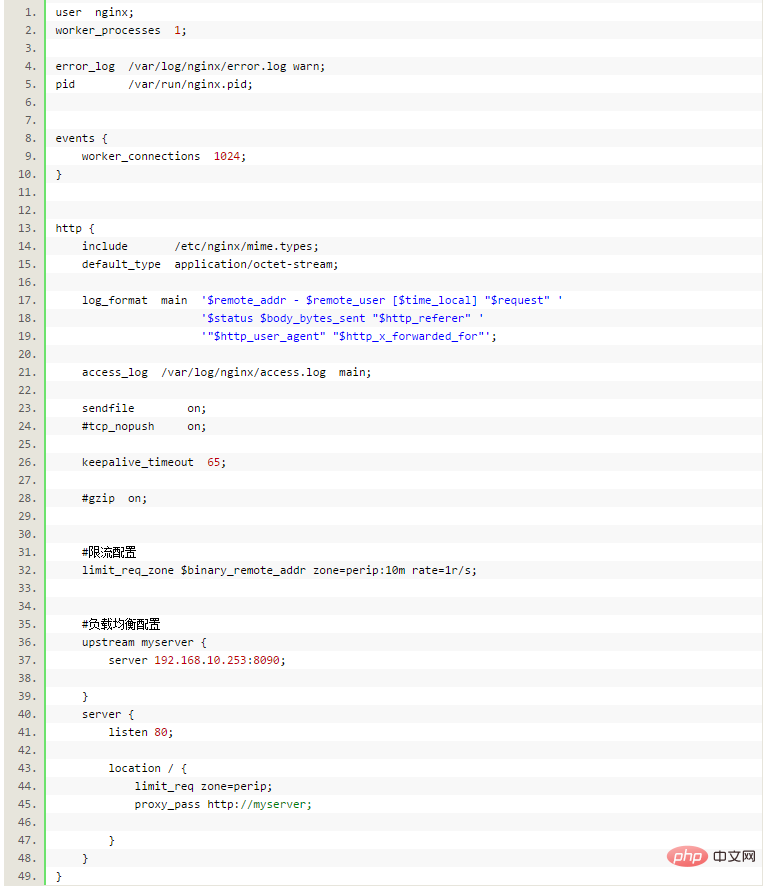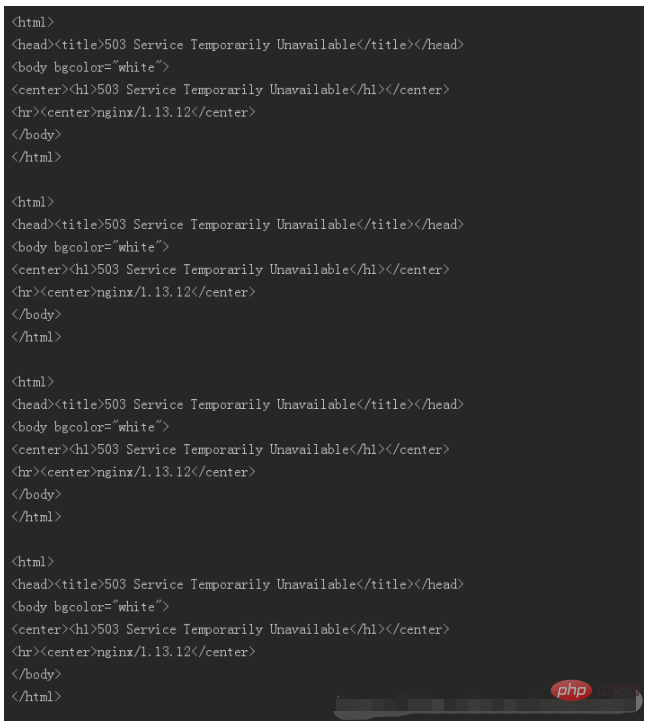How to use nginx to implement distributed current limiting
1. Foreword
Generally, systems that are exposed to the outside world will receive a large number of requests during promotions or hacker attacks. In order to protect the system from being overwhelmed by the high concurrent traffic that arrives instantly, , you need to limit the current.
2. First deploy a program that exposes the interface to the outside world
What I deploy here is a spring boot project, which is exposed as follows The interface is very simple

Exposed a get request to return hello world restful interface.
Deploy this program to the linux server. The deployment steps are not I won't go into details again, you can deploy it by yourself using Baidu spring boot.
I would like to recommend an architecture learning and exchange group to everyone. Communication and learning group number: 575745314. It will share some videos recorded by senior architects: spring, mybatis, netty source code analysis, principles of high concurrency, high performance, distributed, microservice architecture, jvm performance optimization, distributed architecture, etc. These have become a necessary knowledge system for architects. You can also receive free learning resources and benefit a lot so far

3. Create an nginx configuration file named nginx.conf
Create a configuration file named nginx.conf, the complete content is as follows

Explanation of the current limiting part in the configuration file:
As above, The current limiting configuration of nginx has only two lines of code.
The first line:

limit_req_zone: is the current limiting statement.
$ binary_remote_addr: means to limit the current based on the client IP. For example, the current limiting configuration above limits the request frequency of each client IP to once per second. If you act rogue twice per second, the current will be limited and an http 503 error will be returned. Here you go.
zone=perip: Indicates that the name perip is used to identify this line of current limiting configuration. This line of current limiting configuration will be referenced by the name perip later (that is to say, the current limiting configuration can be defined For multiple)
10m: Indicates that the space to store client IP is 10mb, 1mb can store more than 10,000 ips, 10mb can store more than 100,000 ips, reference explanation: ... In this article Search binary_remote_addr to locate relevant explanations.
rate=1r/s: Indicates that the frequency is one request per second.
Second line:

Indicates that on the myserver cluster, use the current limiting configuration named perip
4. Use docker to deploy nginx
Replace the nginx.conf created in the previous step Configuration file, copy it to the linux directory, under /root/nginx/ (the directory can be arbitrary), and then use a docker command to deploy the nginx environment

The 8080 port is exposed here. The load balancing node in the nginx configuration can be accessed through the 8080 port, that is, the 192.168.10.253:8090 ip port. This ip port corresponds to the hello world program that is created and deployed in the first step.
Use code to access the third The helloworld interface defined in one step

I execute 10 get requests per second, which is already greater than the rate=1r/s configured in nginx, which requests once per second. So you will see a 503 error, as follows.

If you change the code and execute the get request once a second, the error will not be reported. You can try it
The above is the detailed content of How to use nginx to implement distributed current limiting. For more information, please follow other related articles on the PHP Chinese website!

Hot AI Tools

Undresser.AI Undress
AI-powered app for creating realistic nude photos

AI Clothes Remover
Online AI tool for removing clothes from photos.

Undress AI Tool
Undress images for free

Clothoff.io
AI clothes remover

Video Face Swap
Swap faces in any video effortlessly with our completely free AI face swap tool!

Hot Article

Hot Tools

Notepad++7.3.1
Easy-to-use and free code editor

SublimeText3 Chinese version
Chinese version, very easy to use

Zend Studio 13.0.1
Powerful PHP integrated development environment

Dreamweaver CS6
Visual web development tools

SublimeText3 Mac version
God-level code editing software (SublimeText3)

Hot Topics
 1386
1386
 52
52
 How to configure cloud server domain name in nginx
Apr 14, 2025 pm 12:18 PM
How to configure cloud server domain name in nginx
Apr 14, 2025 pm 12:18 PM
How to configure an Nginx domain name on a cloud server: Create an A record pointing to the public IP address of the cloud server. Add virtual host blocks in the Nginx configuration file, specifying the listening port, domain name, and website root directory. Restart Nginx to apply the changes. Access the domain name test configuration. Other notes: Install the SSL certificate to enable HTTPS, ensure that the firewall allows port 80 traffic, and wait for DNS resolution to take effect.
 How to check nginx version
Apr 14, 2025 am 11:57 AM
How to check nginx version
Apr 14, 2025 am 11:57 AM
The methods that can query the Nginx version are: use the nginx -v command; view the version directive in the nginx.conf file; open the Nginx error page and view the page title.
 How to start nginx server
Apr 14, 2025 pm 12:27 PM
How to start nginx server
Apr 14, 2025 pm 12:27 PM
Starting an Nginx server requires different steps according to different operating systems: Linux/Unix system: Install the Nginx package (for example, using apt-get or yum). Use systemctl to start an Nginx service (for example, sudo systemctl start nginx). Windows system: Download and install Windows binary files. Start Nginx using the nginx.exe executable (for example, nginx.exe -c conf\nginx.conf). No matter which operating system you use, you can access the server IP
 How to check the name of the docker container
Apr 15, 2025 pm 12:21 PM
How to check the name of the docker container
Apr 15, 2025 pm 12:21 PM
You can query the Docker container name by following the steps: List all containers (docker ps). Filter the container list (using the grep command). Gets the container name (located in the "NAMES" column).
 How to check whether nginx is started
Apr 14, 2025 pm 01:03 PM
How to check whether nginx is started
Apr 14, 2025 pm 01:03 PM
How to confirm whether Nginx is started: 1. Use the command line: systemctl status nginx (Linux/Unix), netstat -ano | findstr 80 (Windows); 2. Check whether port 80 is open; 3. Check the Nginx startup message in the system log; 4. Use third-party tools, such as Nagios, Zabbix, and Icinga.
 How to run nginx apache
Apr 14, 2025 pm 12:33 PM
How to run nginx apache
Apr 14, 2025 pm 12:33 PM
To get Nginx to run Apache, you need to: 1. Install Nginx and Apache; 2. Configure the Nginx agent; 3. Start Nginx and Apache; 4. Test the configuration to ensure that you can see Apache content after accessing the domain name. In addition, you need to pay attention to other matters such as port number matching, virtual host configuration, and SSL/TLS settings.
 How to create a mirror in docker
Apr 15, 2025 am 11:27 AM
How to create a mirror in docker
Apr 15, 2025 am 11:27 AM
Steps to create a Docker image: Write a Dockerfile that contains the build instructions. Build the image in the terminal, using the docker build command. Tag the image and assign names and tags using the docker tag command.
 How to start containers by docker
Apr 15, 2025 pm 12:27 PM
How to start containers by docker
Apr 15, 2025 pm 12:27 PM
Docker container startup steps: Pull the container image: Run "docker pull [mirror name]". Create a container: Use "docker create [options] [mirror name] [commands and parameters]". Start the container: Execute "docker start [Container name or ID]". Check container status: Verify that the container is running with "docker ps".




